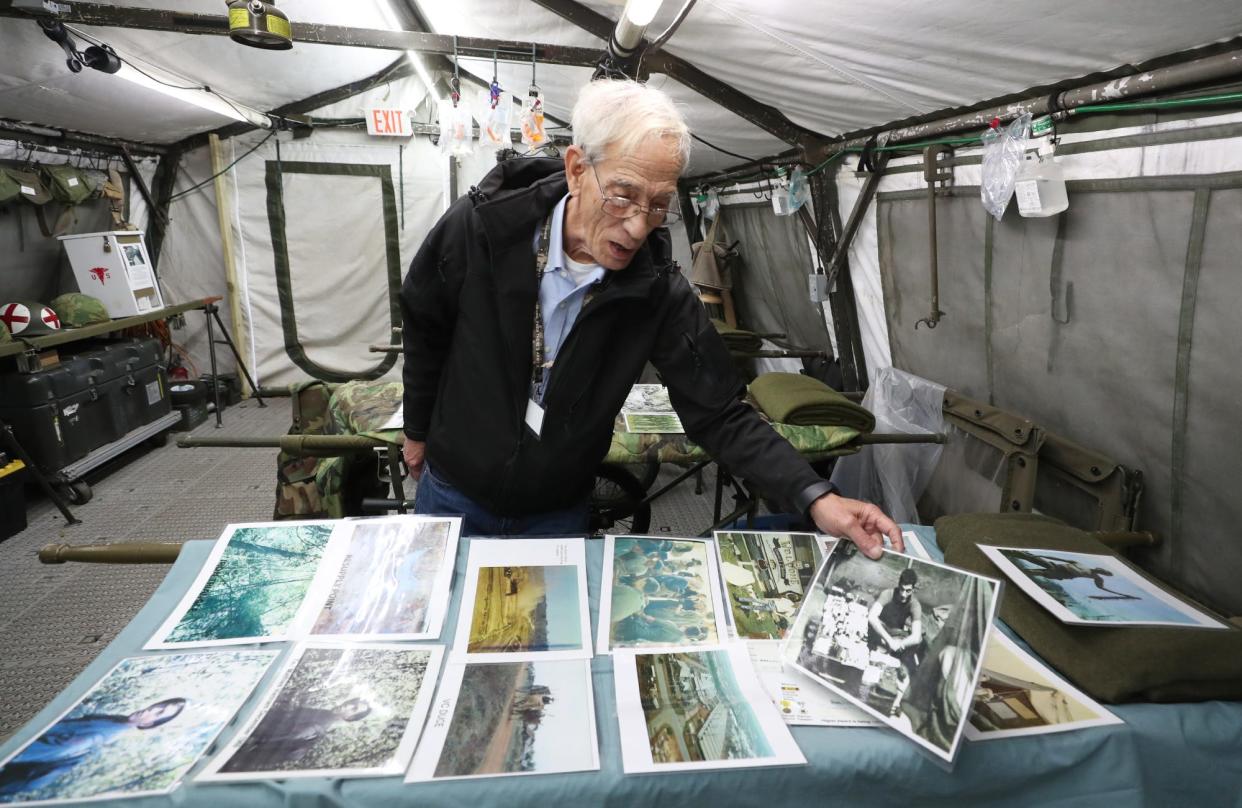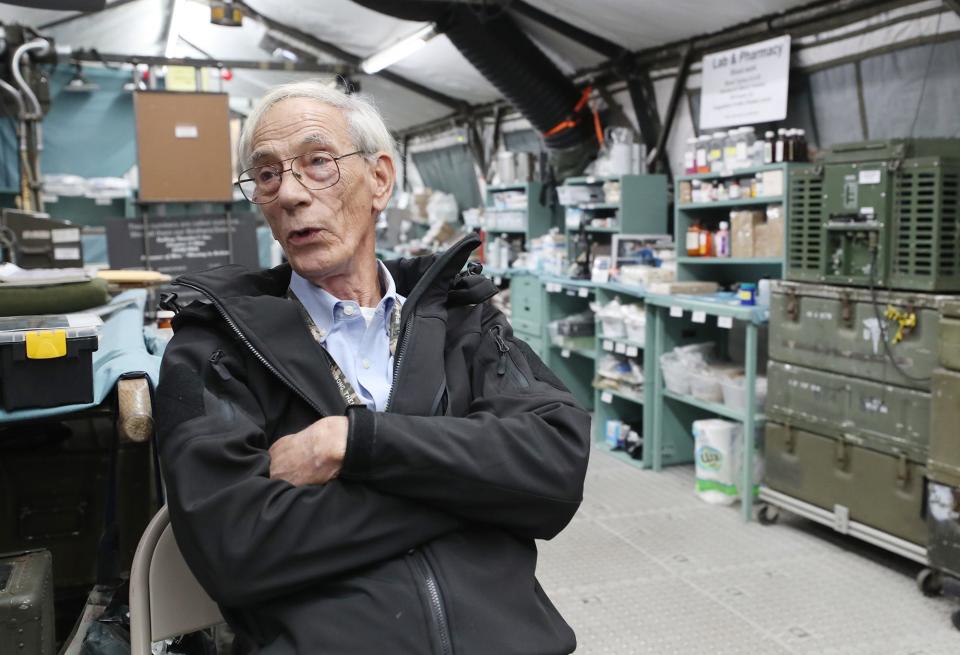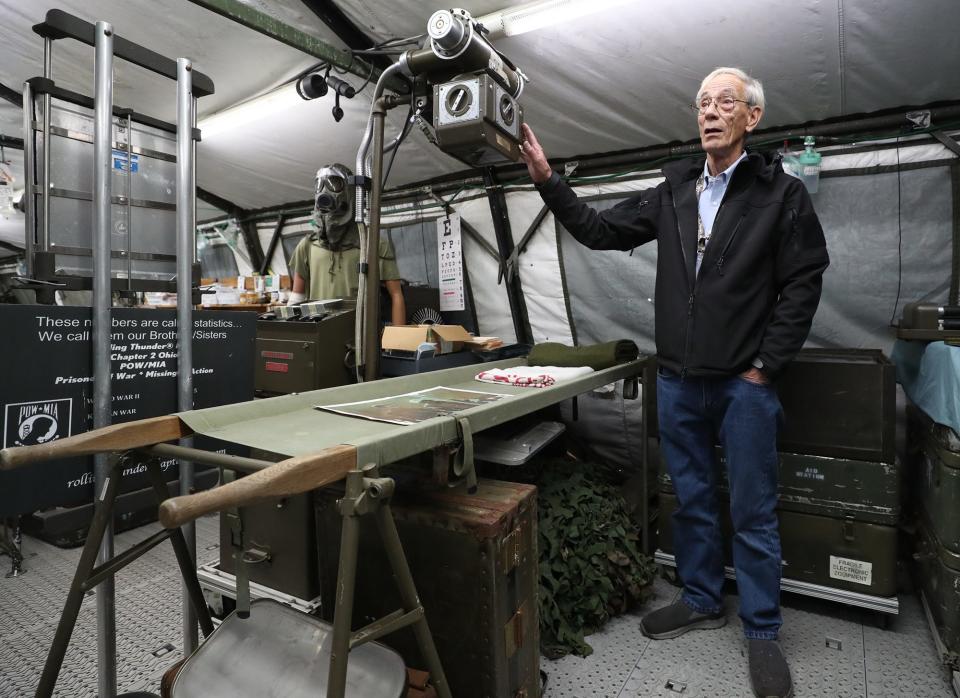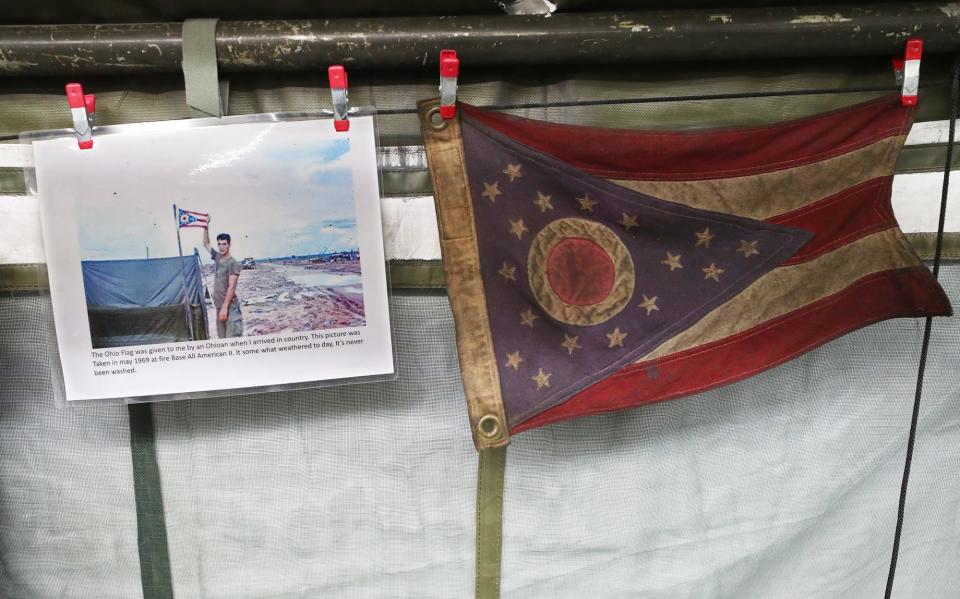‘It’s not a story. It’s real.’ Vietnam veteran recalls medic’s life with museum exhibit

Some veterans don’t talk about their war experience.
Ted Mathies, 75, who served as an Army combat medic in the Vietnam War, is an exception. He not only discusses his military service, but also demonstrates it with a detailed exhibit at the MAPS Air Museum in Green, where he has volunteered for more than a decade.
“I came here for another event and just never left,” he said with a chuckle.
More: What is closed on Veterans Day 2023? Here's what you need to know about the holiday
His personal collection of military medical equipment is on display at Medic’s Corner, a tent outside the hangar of the museum at 2260 International Parkway next to Akron-Canton Airport.
Filled with hundreds of items, including medical supplies, instruments, stretchers, bandages, IV equipment and a portable X-ray machine, the 1,000-square-foot tent is Mathies’ simulation of a forward aid station and surgical area like those he saw in combat.
He wants visitors to visualize what he experienced.
“The primary reason is it’s not a story. It’s real,” Mathies said. “And this is what it looked like — as close as I can get it to Vietnam.”
When guests open the flap and step inside, they enter the Iron Triangle along Thunder Road, just like Mathies did more than 50 years ago.
“I get doctors that come in here that served in Vietnam,” he said. “And they’ll tell their wife: ‘This is it. This is what it looked like.’ ”
Welder becomes Army medic
Mathies never dreamed as a child that he would be a medic. Born in Akron, the son of Bart and Eloise Mathies grew up in Cuyahoga Falls with four siblings. His mother was a beautician, and his father ran a body shop.
He graduated from Cuyahoga Falls High School in 1965 and worked as a welder at Massey Ferguson.
In December 1968, Mathies got drafted into the Army. He started basic training at Fort Campbell in Kentucky before transferring to Fort Sam Houston in Texas.
“They just pulled seven of us out of basic and said, ‘You’re going to be medics,’ and gave us airplane tickets,” he said.
He still isn’t sure why he was selected. It may have been because he took first-aid classes with the Civil Air Patrol as a kid.
Mathies underwent nine weeks of hospital training, learning how to wrap bandages, make beds and give baths. The trainees practiced giving each other shots and starting IVs. They learned to suture on sponges and practiced carrying stretchers.
From there, the Ohio boy shipped out to the 90th Replacement Center in Bien Hoa, Vietnam, and got assigned to the 82nd Airborne Division in Phu Loi, where he had one week of combat training.

He entered combat as a field medic with the 1st Battalion, 505th Infantry, carrying 120 pounds of gear. His pack was filled with medical supplies, four days of food and five quarts of water, but it got a little lighter each day.
“You eat your way out of it,” he explained.
In the heat of battle, he evacuated casualties, did triage work and made assessments, treating bullet wounds, shrapnel wounds and traumatic injuries. When mines exploded, Mathies ran to help the wounded.
The training kicked in. He did his job, operating on instinct.
“You’d be surprised what you can do,” Mathies said. “Most people only operate at 40%. After training and you know your responsibility, it’s all clinical after that. You don’t see the mess. You see ‘What do I need to do?’”
By his estimate, he treated about 60 combat wounded, 1,500 women and children in schools, villages and orphanages, and three or four enemy soldiers. Perhaps mercifully, Mathies has little memory of the wounds he treated.
“Everything in combat is strange and weird and unbelievable,” he said. “You can have a stroke of luck or a stroke of fate. And they can both happen a second apart.”
Reassigned to 1st Infantry Division
Mathies served with the 82nd Airborne until November 1969, when he was reassigned to the 1st Infantry Division — “The Big Red One” — and joined Bravo Company with the 2nd Battalion, 18th Infantry.
Soldiers called him “Doc,” which he took as the highest compliment.
It was a hard slog along Thunder Road in the Iron Triangle. After traveling with the infantry for four to five weeks, he would get a three-day break. Mathies returned to the forward aid station to lend a hand, supplementing his medical training by chatting with battalion surgeons and asking questions.
Then he would go back out in the field. One time, Mathies had to set up a forward aid station because no doctors were available. He ran it for weeks before another medic arrived.
“It ended up in the end we had five medics out there,” he said. “And then I realized that we were all burned out. We all had 10-plus months in the field. So we were a warehouse for burnouts. We finally did get a doctor — and he was from Cuyahoga Falls! He did his intern at Green Cross.”
After the war
Mathies’ rank was E-5, or sergeant, when he left Vietnam in the spring of 1970. His awards and decorations include the Bronze Star, Army Commendation Medal with Oak Leaf Cluster, Air Medal with Oak Leaf Cluster and Combat Medic Badge.
After the Army, Mathies returned to Massey Ferguson as a welder before joining Mercury Real Estate, where he served as maintenance manager for Coventry Plaza, Stow-Kent Plaza and State Road Shopping Center.
Mathies graduated from the U.S. Institute of Technology and worked at O’Neil’s in downtown Akron, handling the store’s refrigeration and air conditioning. He later served as maintenance manager for Rudco Industries, facilities engineer for Alliance Manufacturing and corporate machine controls manager for Lexington Technologies in North Canton. He is now retired in Marlboro Township.
Around 1987, he bought an IV bottle at a flea market in Findlay. He thought maybe he’d set up a stretcher display for the nonprofit group Marlboro Volunteers.
He added a few items and suddenly had a collection.
“It grew from there,” he said.
Through flea markets and eBay purchases, he accumulated gear similar to what he used in Vietnam. He drove to Illinois to pick up a Cleveland-made 1943 Picker X-ray machine and added a Picker Polaroid X-ray film developer.

Mathies set up Medic’s Corner around 2012 at the MAPS Air Museum, joining other veterans who volunteer their time.
“I had always been looking for a place where the focus is on educating the public,” said Mathies, who has been giving talks to students, scouts and other groups since the late 1980s.
In the spring, when the museum is booked solid with school programs, he’s in the tent about seven days a week. In the fall, his typical shift is 9 a.m. to 2 p.m. on three days.
Mathies relishes the opportunity to answer questions as thousands of kids pass through each year. Younger children, in particular, are so inquisitive.
“If they want to know about it, they’ll ask about it,” he said. “Those are the ones I love.”
PTSD and Agent Orange
Mathies thanks Veterans Affairs counselors for helping him get a handle on the post-traumatic stress disorder he’s endured over the years. He battled anxiety in the 1990s, and it became overbearing around 2010. With VA’s aid, he’s developed a better understanding of what drives intrusive thoughts.
“Now I can blame it on Vietnam and not everybody around me,” he said with a laugh.
That’s not all that Mathies brought back from the war.
“I lost the left lower lobe of my lung to Agent Orange,” he said. “I’ve had three different cancers. None at the moment.”
Happily, he and his wife, Judith, celebrated their 50th anniversary this year.
“Considering PTSD, that’s remarkable,” he said. “She was an Air Force brat, so she has high tolerance.”

Running the Medic’s Corner has been therapeutic. When Mathies was in the Army, the forward aid station was his refuge.
“Every time I open the tent up in the morning, I feel the stress leave me,” he said. “This, to me, as far as Vietnam goes, was a safe place.”
His only source of funding is the money that visitors leave in donation boxes. He also accepts donations of gear, which people drop off.
Mathies has been busy repairing equipment for the past month. In December, he’ll pack up for the season. But you can bet he’ll return in the spring.
Students will be back to ask more questions, and he will be there to offer a firsthand account of being a combat medic in Vietnam.
It’s not a story. It’s real.
“The reason I am here is to talk to those kids,” he said.
Mark J. Price can be reached at mprice@thebeaconjournal.com
More: Civil War veteran’s headstone unearthed at Glendale
This article originally appeared on Akron Beacon Journal: Vietnam veteran has medic exhibit at MAPS Air Museum

